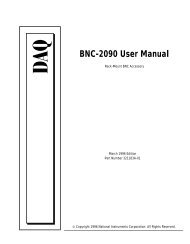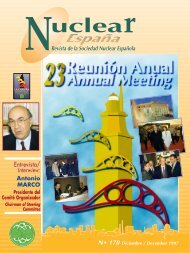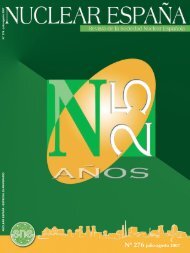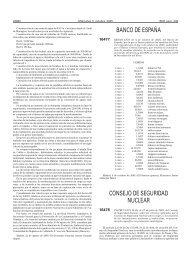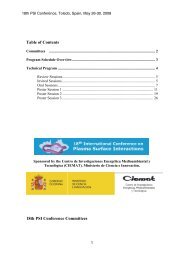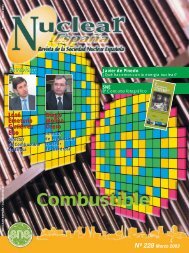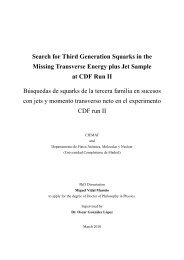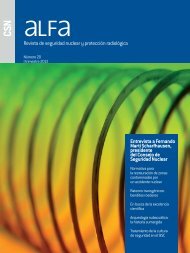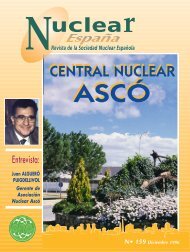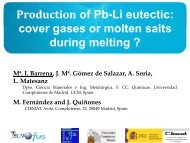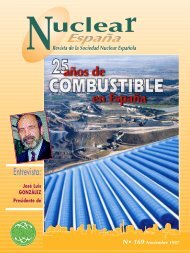EntrEntr evista/evista/ InterInter viewview
EntrEntr evista/evista/ InterInter viewview
EntrEntr evista/evista/ InterInter viewview
Create successful ePaper yourself
Turn your PDF publications into a flip-book with our unique Google optimized e-Paper software.
CENTRALES NUCLEARES/NUCLEAR POWER PLANTS<br />
DECIMOTERCERA RECARGA<br />
UNIDAD I<br />
La mencionada parada de recarga<br />
tuvo su inicio, tal como estaba previsto,<br />
a las 00,00 horas del día 29<br />
de mayo con el desacoplamiento<br />
del alternador de la red. Las actividades<br />
más destacables realizadas<br />
fueron las siguientes:<br />
• Medida del tiempo de caída de<br />
barras de control.<br />
• Durante el enfriamiento del circuito<br />
primario se detectaron valores<br />
de radiación anormalmente altos,<br />
comparados con los obtenidos en la<br />
recarga anterior en puntos de la<br />
Planta en contacto con dicho circuito<br />
y sistemas asociados como<br />
consecuencia del fallo de una fuente<br />
secundaria de neutrones del reactor<br />
que contribuyó a la propagación<br />
de los isótopos Sb-124 y<br />
Sb-122 en el agua del RCS. Por esta<br />
razón se mantuvo el circuito primario<br />
con una bomba de refrigeración<br />
en servicio, prolongándose las actividades<br />
de purificación hasta conseguir<br />
bajar los niveles de actividad<br />
en el agua del circuito primario hasta<br />
valores recomendados por el<br />
EPRI.<br />
• Los niveles de actividad en la<br />
cota de operación fueron similares<br />
a los de la recarga anterior, y no variaron<br />
a lo largo de la descarga del<br />
combustible, ni de la descarga de<br />
las fuentes neutrónicas. En paralelo<br />
a la descarga de elementos combustibles,<br />
se efectuó una inspección visual<br />
de toberas y rejillas con resultados<br />
satisfactorios.<br />
• Se drenaron los tres generadores<br />
de vapor y se realizó limpieza<br />
de la placa tubular “lancing”. En el<br />
generador de vapor 2 se realizó inspección<br />
por corrientes inducidas al<br />
9% de tubos y se inspeccionó la<br />
placa tubular, con resultados satisfactorios.<br />
• Durante las maniobras de traslado<br />
de elementos de combustible<br />
nuevo a la piscina de combustible<br />
gastado se dañó un elemento, por<br />
lo que fue necesaria la fabricación<br />
en Enusa de un nuevo elemento<br />
combustible.<br />
• Se llevó a cabo la sustitución<br />
de cabezales a 18 elementos de<br />
combustible gastado.<br />
• Se realizó inspección de cierres<br />
a las bombas de refrigeración del<br />
reactor RCP-1 y RCP-3.<br />
• Se realizó inspección a 39 penetraciones<br />
del recinto de contención.<br />
• Se hizo mantenimiento de ambos<br />
trenes de salvaguardias tecnológicas<br />
y prueba integrada de rodaje<br />
de 24 horas a los generadores diesel<br />
1DG y 3DG, con resultados satisfactorios.<br />
• En el turbogrupo se realizaron<br />
trabajos de rigidizado de ambas tapas<br />
de las turbinas de baja presión.<br />
• Se realizó comprobación de<br />
huelgos entre partes fijas y móviles<br />
a las turbinas de baja presión con<br />
resultados satisfactorios.<br />
• Se desmontó la tapa de la turbina<br />
de alta presión y se realizó comprobación<br />
de centrado entre coronas<br />
exteriores y cilindro central<br />
respecto al rotor.<br />
• Inspección de válvulas de turbinas.<br />
• Se desmontó el conjunto de excitación<br />
del alternador para inspección<br />
del mismo.<br />
• Se procedió a la carga del nuevo<br />
núcleo, compuesto por 64 elementos<br />
de combustible nuevo, 9<br />
the tube plate cleaned by lancing. In steam<br />
generator 2, 9% of the tubes were inspected by<br />
induced currents and the tube plate was inspected<br />
with satisfactory results.<br />
• A fuel assembly was damaged while transferring<br />
new fuel assemblies to the spent fuel pool, and<br />
therefore a new fuel assembly had to be<br />
manufactured by Enusa.<br />
• The heads of 18 spent fuel assemblies were<br />
replaced.<br />
• The seals of reactor cooling pumps RCP-1 and<br />
RCP-3 were inspected.<br />
• 39 containment penetrations were inspected.<br />
• Maintenance was performed on both<br />
engineered safety feature trains, and an integrated<br />
24-hour running test was performed on diesel<br />
generators 1DG and 3DG, with satisfactory results.<br />
• In the turbine set, work was carried out to<br />
rigidify both low-pressure turbine heads.<br />
• The play between stationary and moving parts<br />
of the low pressure turbines was checked with<br />
satisfactory results.<br />
• The high pressure turbine head was dismounted<br />
to check the centering between exterior rings and<br />
center cylinder with respect to the rotor.<br />
• Turbine valve inspection.<br />
• The alternator excitation assembly was<br />
dismounted for inspection.<br />
• The new core was loaded; this core is<br />
composed of 64 new fuel assemblies, 9 assemblies<br />
reused from cycles prior to no. 13, and the<br />
remaining 84 are from cycle 13.<br />
The tests established in the startup sequence were<br />
then performed, the reactor became critical on July<br />
7 and the Unit went on-line on July 9, thus marking<br />
the end of the refueling outage, which lasted 41 days<br />
and 4 hours.<br />
OPERATING ACTIVITES<br />
UNIT I<br />
In addition to the refueling outage, this Unit had<br />
another two outages during the year: one for<br />
inspecting one of the main pumps, and the other a<br />
reactor scram.<br />
• During startup after the refueling outage, higher<br />
than normal vibrations were detected in the cooling<br />
pump of Reactor No. 2; therefore, after reaching<br />
50% power, it was decided on July 11 to shut down<br />
the Unit in order to inspect/repair this pump. On<br />
inspection, damage was found in the lower motor<br />
bearing, which was repaired by replacing the<br />
bearing. The unit went on line again on July 17.<br />
• On July 17, while uploading after the above<br />
mentioned shutdown, a reactor scram occurred due<br />
to automatic turbine shutdown when high level was<br />
reached in steam generator 2. This was a result of<br />
level oscillations during manual control with<br />
nuclear power at 25%; due to the system’s instability<br />
at low loads, this level rose above trip point. The<br />
Unit went on-line again on the same day, and since<br />
then has been connected to the grid without<br />
interruption.<br />
UNIT II<br />
This Unit experienced two reactor scrams during<br />
the year, as described below:<br />
• On April 6, an automatic reactor and turbine<br />
shutdown occurred due to a failure in the<br />
mechanism of a reactor scram switch when it was<br />
being routinely checked in accordance with<br />
provisions of the Technical Operating<br />
Specifications. On the same day the reactor<br />
A b r i l 2 0 0 0<br />
R e v i s t a S N E




